#Le Roy Jucep
Explore tagged Tumblr posts
Text
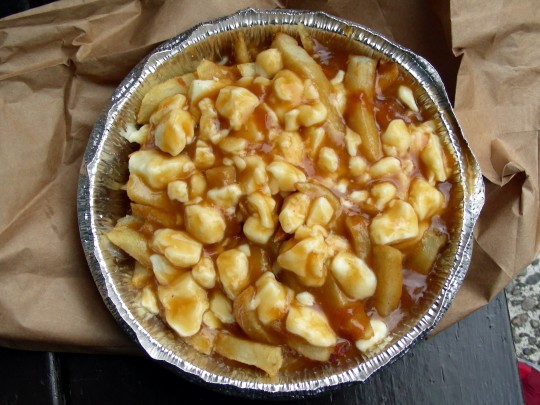
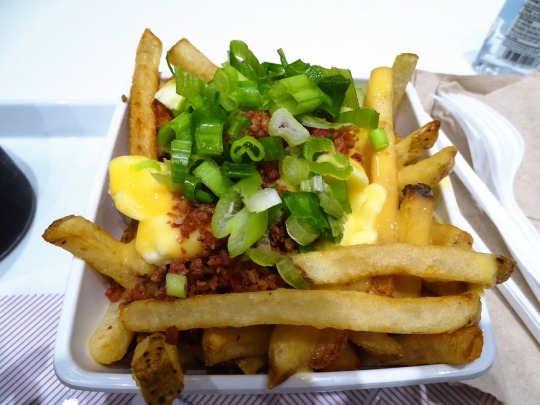


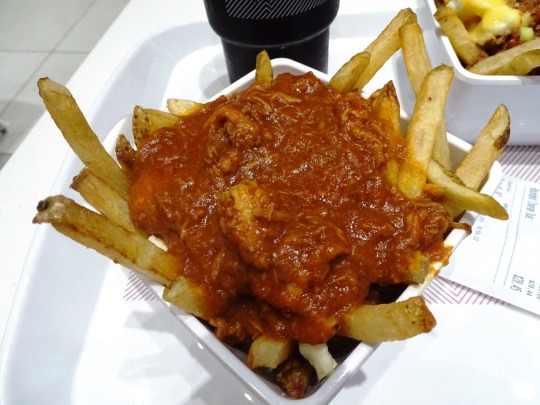

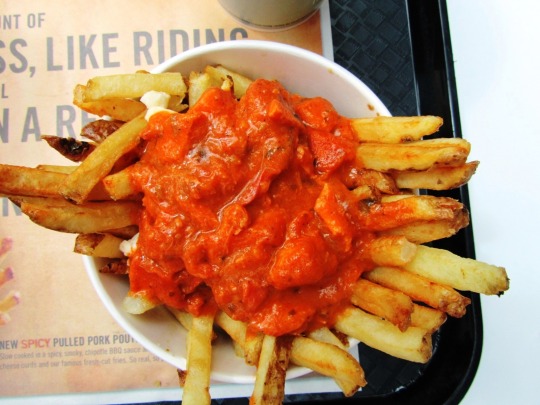
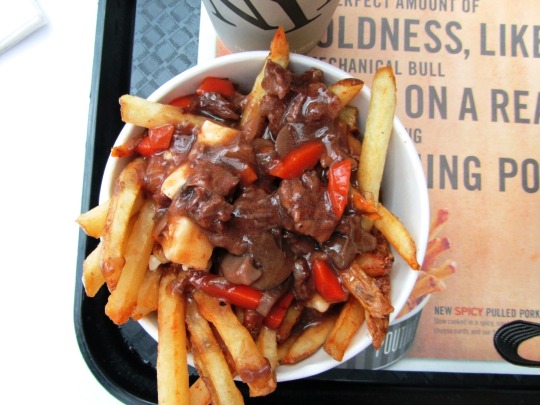
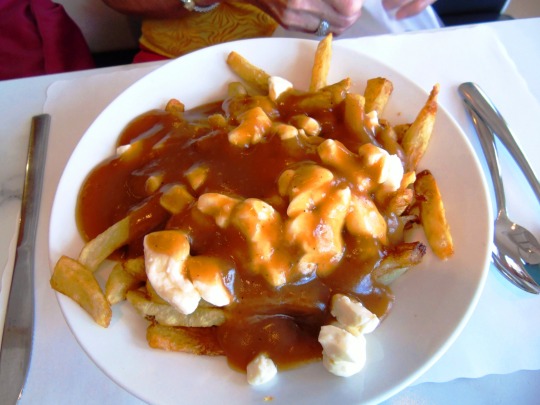
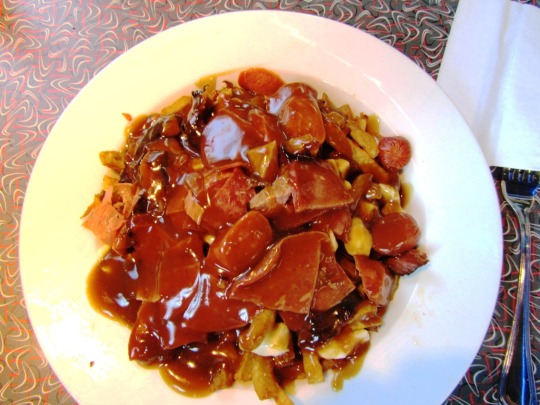
National Cheese Curd Day
National Cheese Curd Day was created by Culver's, a fast-food restaurant that started in Wisconsin that is located mainly in the Midwest, that as of 2020 has restaurants in 25 states. One of their most popular menu items, their cheese curds, are made with white and yellow Cheddar cheese. The fresh cheese curds—which they source from LaGrander's Hillside Dairy in Stanley, Wisconsin—are breaded with their signature blend of herbs and spices and then deep-fried. Culver's sold over 17.7 million orders of cheese curds in 2015, and over 28 million orders in 2018. During the month of October, when they hold National Cheese Curd Day, they offer chances for people to win cheese curds and other prizes. They've even given away a year's supply of cheese curds as their grand prize.
Cheese curds are popular in the Midwest, particularly in Wisconsin. They also are common in Quebec, Canada. Cheese curds are fresh, made by separating the curd from whey during the cheese-making process. Instead of going through the whole process, where a block of cheese is made, a solid curd of cheese with a milky flavor is formed. Cheese curds are mainly made of young Cheddar, either white or yellow, although some are made from mozzarella, Muenster, Colby, or Monterey Jack cheese. Fresh cheese curds are moist and rubberlike and will squeak when eaten when their elastic protein strands rub against tooth enamel. They begin losing their squeakiness after 12 hours and are no longer considered fresh about two days after being made. They are rather mild in flavor with a bit of saltiness and are often flavored with dill, garlic, spicy Cajun, taco seasoning, ranch, or jalapeno.
Cheese curds are commonly eaten as a snack or appetizer. Not only can they be eaten fresh, but they can be deep-fried, after being covered with a breading or batter—sometimes a beer batter. They are often then dipped in marinara sauce, ketchup, or ranch dressing. Deep-fried cheese curds are popular at state fairs, carnivals, and bars. They are also common at some fast-food restaurants, Culvers and A&W being two that offer them. Cheese curds are also used to make poutine. No matter if you eat deep-fried cheese curds at Culver's today, or enjoy them somewhere else or made in another manner, you are sure to find National Cheese Curd Day most enjoyable!
How to Observe National Cheese Curd Day
Some ways to observe National Cheese Curd Day include:
Pick up some cheese curds at Culver's. Watch their social media accounts for chances to win cheese curds and other swag.
Have some cheese curds at another restaurant, at a bar, or at a carnival or fair.
Pick up some fresh cheese curds at a store or shop, or make your own.
Make your own deep-fried cheese curds.
Plan a trip to the next Cheese Curd Festival.
Source
#Pulled Pork Poutine#National Cheese Curd Day#street food#restaurant#travel#Canada#Le Roy Jucep#Poutine 911#Drummondville#Québec#Montréal#vacation#original photography#15 October#NationalCheeseCurdDay#Meat Lovers Poutine#Butter Chicken Poutine#fries#gravy
4 notes
·
View notes
Text
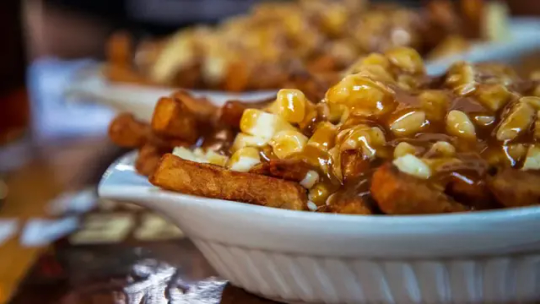
Five of Montreal's best poutine spots - according to a local chef
Montreal-born chef Michele Forgione makes one of the best poutines in the city. Here are his top poutine picks in Montreal, from Chez Ma Tante to Ma Poulle Mouillée.
Piping-hot French fries topped with squeaky cheese curds and brown gravy: in Canada's Quebec province, poutine is tantamount to passion. The beloved dish has become emblematic of the province and opinions abound on which curds make the best topping or how the frying method affects the dish.
Legends about its origins are also plentiful. In a 2015 tourism campaign, the town of Drummondville, Quebec, claimed ownership of poutine, declaring that it was invented in the 1960s by self-proclaimed "l'inventeur de la poutine" Jean-Paul Roy of local restaurant Le Roy Jucep. Another legend states that a customer mixed cheese curds with French fries at restaurant La P'tite Vache in Princeville, Quebec in 1966. But the most prevailing legend points to the town of Warwick, Quebec, in the late 1950s, when restauranteur Fernand Lachance of Le Café Idéal exclaimed "Ca va faire une maudite poutine!" ("It will make a damn mess!") when a customer asked him to put cheese curds in a takeaway bag of frites
Read more...
0 notes
Text
مطعم في كيييك يتخلى عن اسم أحد أطباقه تنديدا بغزو الرئيس الروسي بوتين
مطعم في كيييك يتخلى عن اسم أحد أطباقه تنديدا بغزو الرئيس الروسي بوتين
اخبار كندا – في أعقاب الغزو الروسي لأوكرانيا، ابتكر مطعم في كيبيك طريقته الخاصة للتنديد بفلاديمير بوتين. أعلن مطعم Le Roy Jucep، في مدينة Drummondville الصغيرة، صاحب أفضل طبق poutine في كيبيك، على Facebook يوم الجمعة في منشور قال فيه: “العملاء الأعزاء، قرر فريق Jucep الليلة سحب كلمة P *** tine مؤقتاً من علامتهم التجارية للتعبير عن الاستياء العميق من الوضع في أوكرانيا”. حيث أن لفظ كلمة poutine…
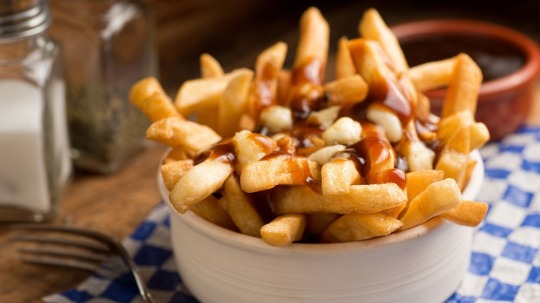
View On WordPress
0 notes
Photo
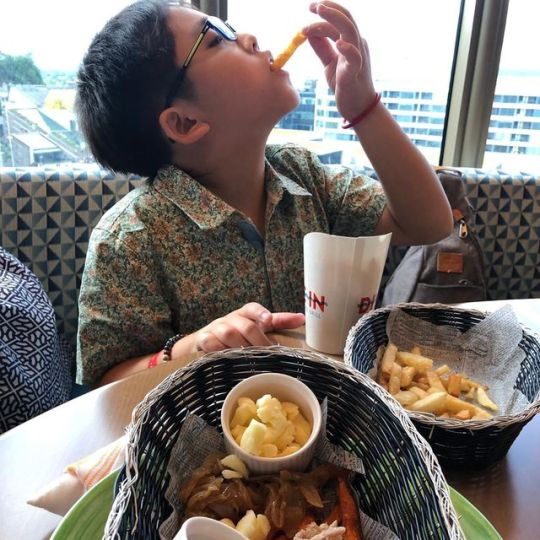
It’s Poutine day at the Lido Deck of Zaandam. Regular fries for The Kid and sweet potato fries for the rest of us. It was calorifically delicious! poutine n. French-Canadian dish traditionally made of French fries and fresh cheese curds, covered with gravy. The most widespread story is that poutine originates from a restaurant formerly called Le Lutin qui rit in Warwick, in the Arthabaska region. In 1957, a client named Eddy Lainesse would have asked the owner Fernand Lachance to mix the cheese curds with the fries. A Drummondville restaurant called Le Roy Jucep registered a trademark stating that it is the inventor of poutine. Jean-Paul Roy, owner of this restaurant in 1964, is the first one to have served poutine as we know it today, i.e. "French fries, cheese and gravy." . . #JoUygongcoPhotography #twp2019Canada #twp2019Zaandam #HollandAmericaZaandam #twpExploresTheWorld #trulyBlessed #lifewelltravelled #creativelifehappylife #travelnowaroundtheworld #triphighlights #DMTravelSeries #tripcendo #adventure #natgeotravel #bbcTravel #landofadventures (at Quebec Vieux-Quebec) https://www.instagram.com/p/Bz7By-EnUvR/?igshid=wfllsn8j6qeh
#jouygongcophotography#twp2019canada#twp2019zaandam#hollandamericazaandam#twpexplorestheworld#trulyblessed#lifewelltravelled#creativelifehappylife#travelnowaroundtheworld#triphighlights#dmtravelseries#tripcendo#adventure#natgeotravel#bbctravel#landofadventures
0 notes
Text
Day trip to Drummondville, Quebec
Looking for a fun day trip from Montreal? Located just one hour away, Drummondville has a lot to keep you busy.
I set out early in the morning for the drive to Drummondville. My plan was to enjoy the outdoors and then check out a few food places.
Parc du Sanctuaire – Saint-Marjorique
In planning this outing, I discovered that Drummondville is home to the largest plantation forest (30 square kilometres) on the south shore of the Saint-Lawrence river between Montreal and Quebec City.
The Parc du Sanctuaire is located in the Foret Drummond which is a section of land that is preserved along both sides of the Saint-François river. This park is free to access and is open all year round.
Since it was early November, the park’s facilities had already closed down for the colder months. The only thing available was a portable bathroom and some outdoor picnic tables. You can do a number of activities in the park depending on the seasons. There is hiking and biking in the warmer months and snowshoeing along with cross country skiing when the snowy weather arrives.
The hiking trails are relatively flat and short in distance, however you can link up a few trails for a longer outing. I ended up doing just under 5 km of walking including a short path that followed the Saint-François river. It’s a great place to get out of the city and take a leisure walk in the woods.
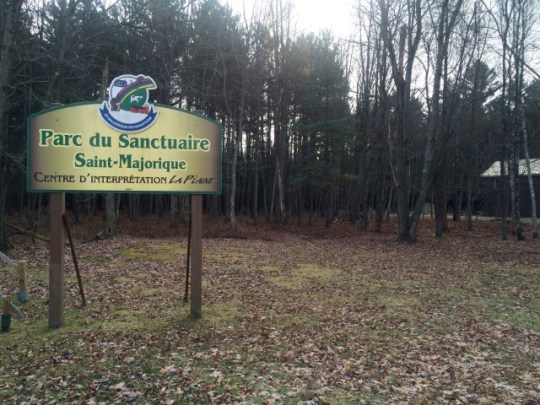
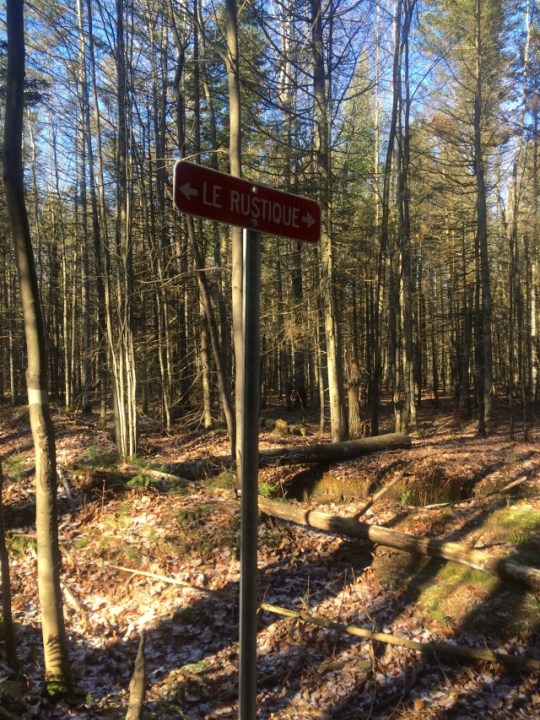
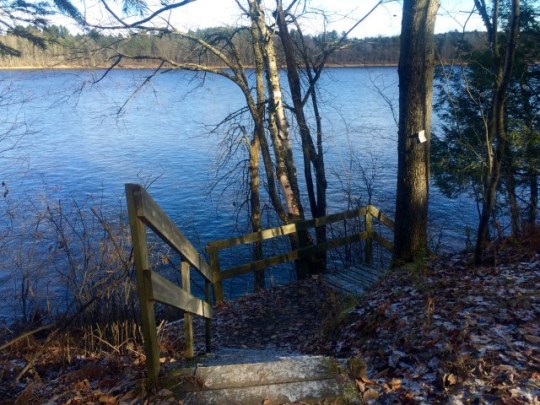
The BockAle Microbrewery (2400 Rue Canadien)
After a morning of walking in the woods, I headed to the Bockale for a cold glass of locally produced beer. The BockAle is a small space with a few long tables, a bar area, and a shop. When I visited, I tried a seasonal beer called the Phoque Datte (love, love the name!), date stout. Given the colder climate, I really enjoyed the rich flavour it had with just a tad of sweetness. Be warned that the bar serves minimal food, with only a few snacks available to accompany the beer. For a late lunch I knew there was only one place I needed to check out…
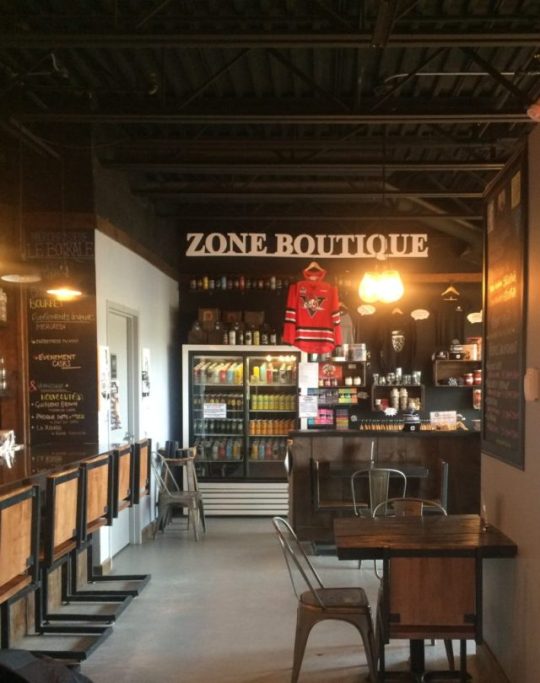

Restaurant Le Roy Jucep (1050 Boul. Saint-Joseph)
Ever wondered where Poutine came from? While many might claim to be the inventor of this famous Quebecois dish, only one place has the legal goods to back up their claim. Restaurant Le Roy Jucep in Drummondville has the Trademark for the Poutine hanging on their wall as proof. I know I had to check this place out while visiting Drummondville. The poutine definitely lived up to expectations. Freshly cut potatoes, rich and slightly sweet gravy, and of course, loads of squeaky cheese. Aside from the food, I loved the vintage vibe of the restaurant with checkered tiles, orange vinyl seats and old black and white photos that decorate the walls.

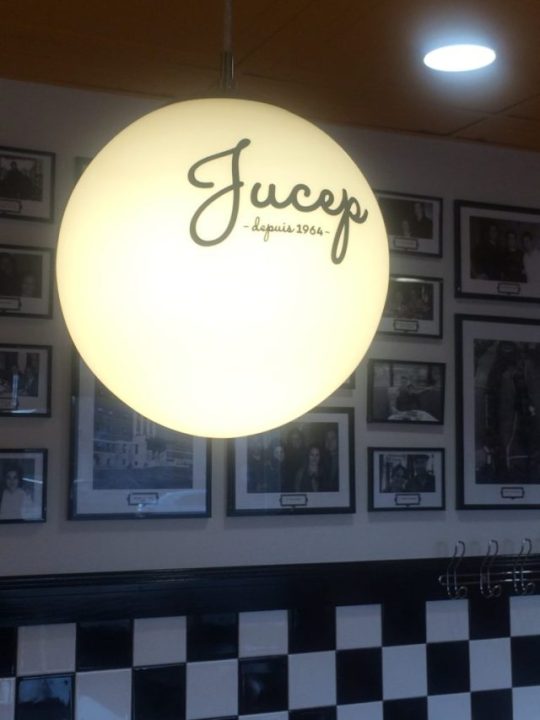
Other Stops in Drummondville
If you have more time on your hands, I would definitely check out Rose Drummond (210 Boulevard Lemire O). They are one of the largest producers of roses and they make a number of products derived from the flower. There is also a charming cafe where you can grab a meal.
Another option is to visit the renowned Village Québécois d’Antan (1425, rue Montplaisir), a family friendly attraction that immerses you in the rich history and tradition of Quebec.
Day trip to Drummondville, Quebec was originally published on Carlas Canvas
0 notes
Photo
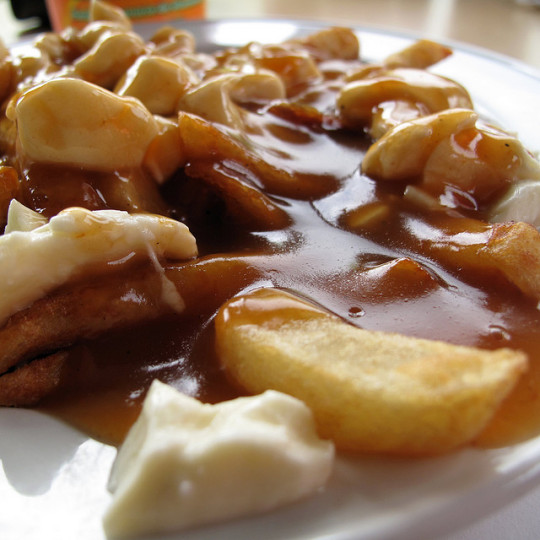
Poutine, Le Roy Jucep, Drummondville by Backpack Foodie on Flickr.
THANK GOODNESS I can't (or don't know where to) find it in this country, because I would INHALE it.
3 notes
·
View notes
Text
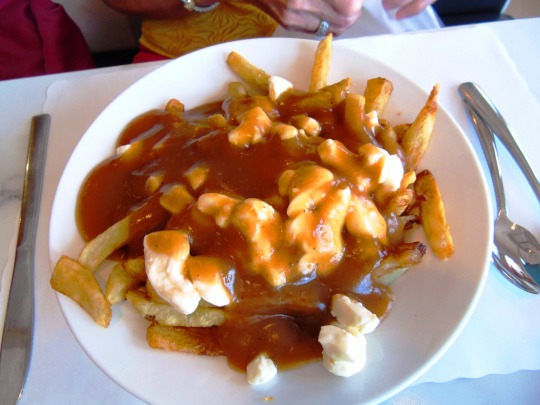
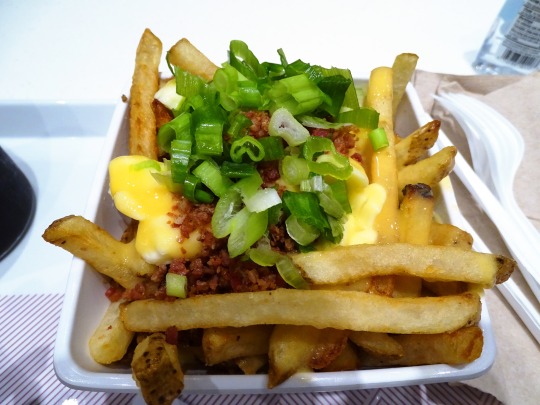
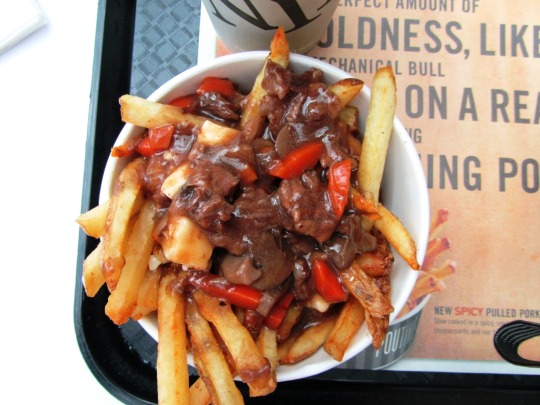
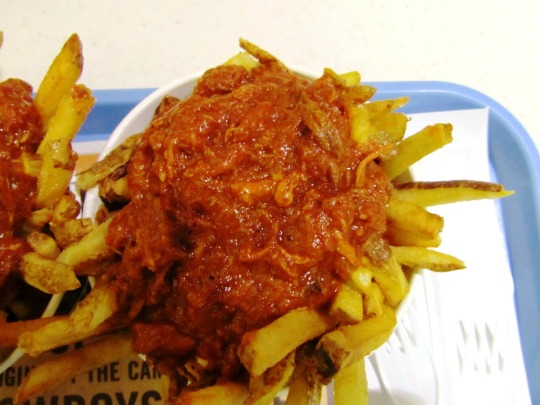
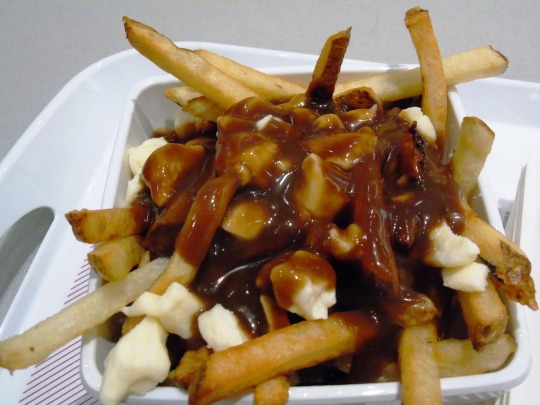

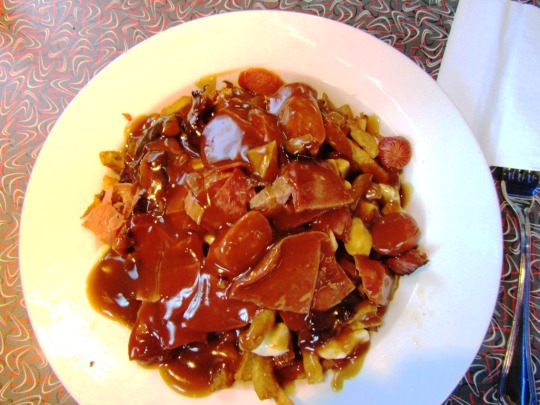
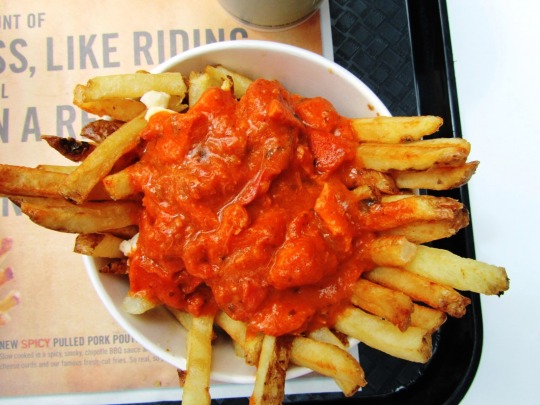
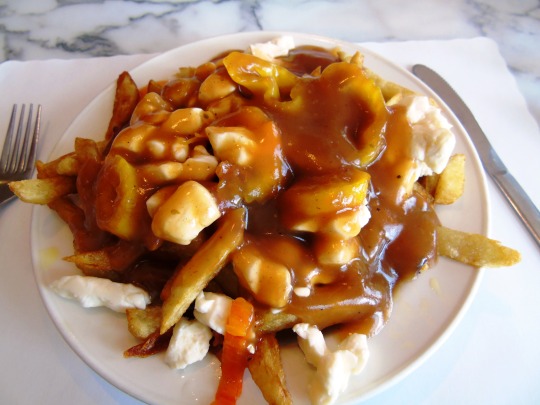
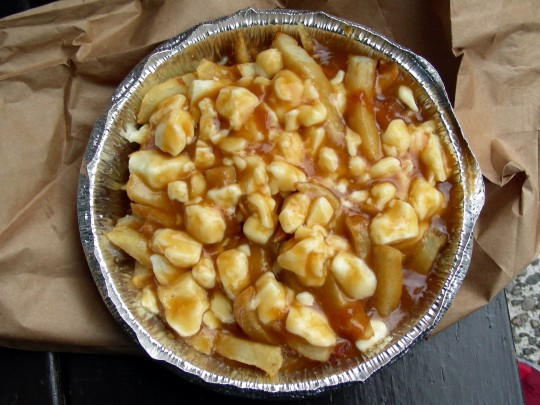
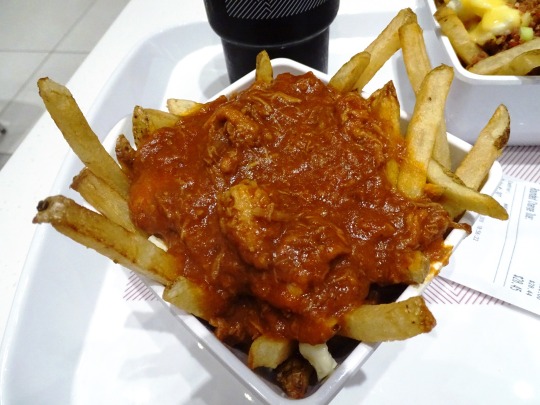
National Poutine Day
While in Winnipeg, Manitoba, filming Bravetown, Danny Rodriguez gained an affinity for poutine. Following his return to the United States he created National Poutine Day, and with partners, opened a Smoke’s Poutinerie branch in Berkeley, California, the first location of the chain in the country. While the Berkeley restaurant has since closed, the poutine holiday he created continues to be celebrated!
In Canada, particularly in Quebec, poutine is a staple food, if not also an iconic one. It has become a popular food in America as well as in other countries. Standard poutine is made up of fresh-cut french fries, squeaky fresh cheese curds, and brown gravy, but there are many variations of the dish. Among other possibilities, the name may have come from the word “pudding,” which is spelled pouding in French, or from poutine, which is slang for “mess” in Quebec. It is pronounced “pou-tin” in the French-dominated regions of Quebec and New Brunswick, but as “poo-teen” elsewhere.
According to the most widely known and accepted story, poutine was first served at L'Idéal (Café Ideal)—a restaurant that later changed its name to Le Lutin Qui Rit (The Laughing Elf)—in 1957, in the small town of Warwick, in Arthabaska County, Quebec, a town known for producing squeaky cheese curds. A usual customer, Eddy Lainsesse, requested curds on top of his fries. The restaurant owner, Fernand Lachance, supposedly replied, “Ça va faire une maudite poutine,” which roughly translates to “That’s going to make a dreadful mess.” A variation of the story says that Lainsesse asked for the curds and fries to be thrown together in a paper bag, upon which Lachance looked into the bag and said, “This is poutine.” The dish started being sold in a bag and soon caught on. Patrons began adding ketchup and vinegar to it. In 1963, Lachance began serving it on plates. Customers soon noticed that the fries got cold quickly, so Lachance added gravy to keep them warm.
According to another story, poutine was created by Jean-Paul Roy, owner of Le Roy Jucep, a drive-in restaurant in Drummondville, Quebec. He had been serving a dish of gravy and french fries called palate-sauce since 1958, and in 1964 noticed that some of his diners were adding cheese curds to it. He soon added a dish that contained all three ingredients and named it fromage-palate-sauce.
No matter how poutine got its start, it soon could be found being sold as street food in Canada. By 1969 it was being sold in Quebec City at the Ashton Snack Bar food truck on Boulevard Wilfred-Hamel, and it was being sold in Montreal by 1983. By the early 1980s, it had become a widely popular street food in Ontario and Quebec.
It made its debut in Canadian chain restaurants in 1985, appearing on the menu at Frits, a now-defunct Quebec-based chain. By the 1990s, poutine had reached mass popularization in the country, after its inclusion on the menus of other chains. It first appeared on a Burger King menu in 1987 in Quebec, and soon spread to other locations of the chain. The same happened with McDonald’s in 1990. Canadian fast-food chain Harvey’s debuted it on menus across the country in 1992.
But poutine wasn’t to remain only as street food and fast food. By the early 2000s, it was appearing in high-end Canadian restaurants. It was put on the menu at Aud Pied de Cochon in Montreal in 2002, where it was topped with foie gras. Other high-end Montreal restaurants followed suit. Garde Manger began serving an Iron Chef America-winning lobster poutine, and Pub Quartier Latin put poutine made with steak, truffles, and red wine demi-glace on their menu.
Some Canadian restaurants have made poutine their main focus. La Banquise in Montreal began serving it in the 1980s. They started with the standard version and an Italian version with bolognese sauce instead of gravy. They have since expanded to serving 30 types. Smoke’s Poutinerie was started in Toronto in 2008, the first poutine-only restaurant in that city. Other poutine-only restaurants that followed in Canada are Poutini’s House of Poutine, La Poutinerie, and Poutineville.
Poutine made its first foray into the United States in New Jersey and New York, where a variation of the recipe called “Disco Fries” became popular. This version substituted mozzarella or cheddar cheese for the curds. Poutine has since become relatively common in the States and has taken hold in other countries as well, such as the United Kingdom and Russia.
As mentioned, there are various types of poutine besides the usual french fries, cheese curds, and gravy combination. Different types of potatoes, cheese, and sauces can be used. Italian poutine may use spaghetti sauce instead of gravy; veggie poutine is made with mushroom sauce and vegetables; Irish poutine is made with lardons. La galvaude is from Gaspésie and is made with chicken and green peas. A variation in Montreal uses smoked meat. With so many types of poutine—and so many restaurants that serve it around the world—there is no reason to remain hungry on National Poutine Day!
How to Observe National Poutine Day
There are numerous ways to celebrate!
Make your own poutine. You could make the original version or another variation of the dish. You could even make Disco Fries, the Americanized version of the dish.
Check if there is a place near you that serves poutine.
Have poutine at one of the best places in the United States that serve it.
Enjoy poutine at a Smoke’s Poutinerie or at another Canadian restaurant that specializes in the dish, such as La Banquise, Poutini’s House of Poutine, La Poutinerie, or Poutineville.
Have poutine at a restaurant in Warwick, Quebec, the town where the dish is said to have originated, or have it at Le Roy Jucep in Drummondville, Quebec, the other location where it is said to have gotten its start.
Eat some poutine at Harvey’s or at another Canadian fast-food restaurant.
Enjoy poutine at a high-end Canadian restaurant such as Au Pied de Cochon, Garde Manger, or Pub Quartier Latin.
Plan a trip to an upcoming poutine fest, such as Montreal’s La Grand Poutinefest or Ottawa Poutine Fest.
Source
#Pulled Pork Poutine#Bacon Double Cheese Poutine#Poutine the Works#travel#Canada#Poutine 911#Le Roy Jucep#Drummondville#Québec#street food#restaurant#Meat Lovers Poutine#Butter Chicken Poutine#vacation#National Poutine Day#5 March#NationalPoutineDay#tourist attraction#national day#Poutin
3 notes
·
View notes
Text
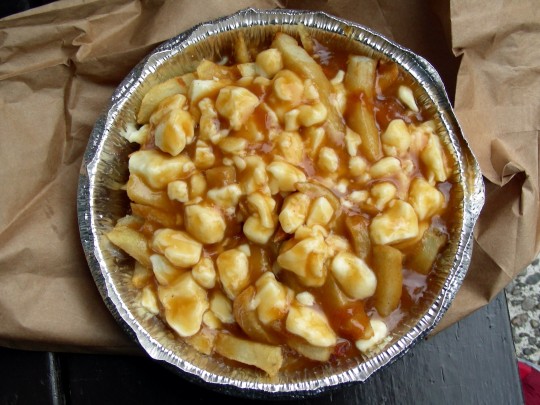
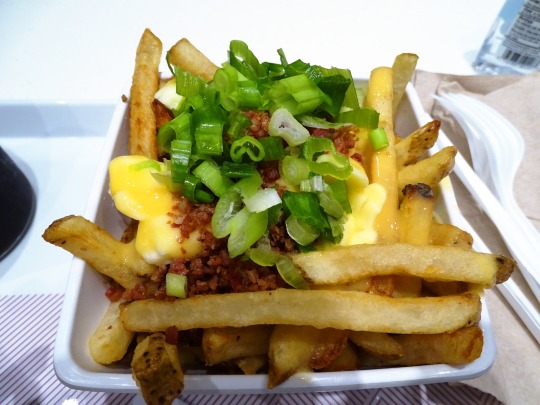
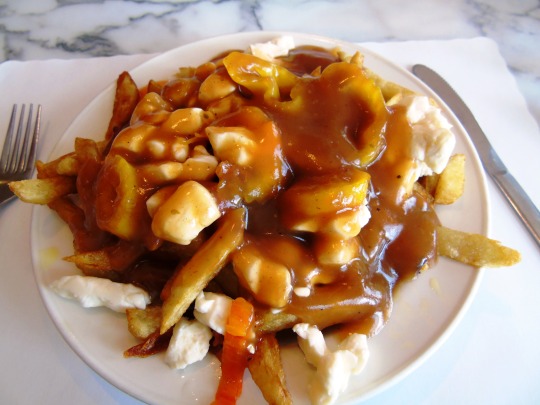
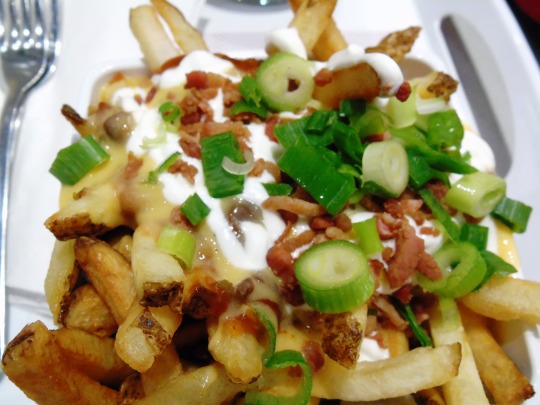
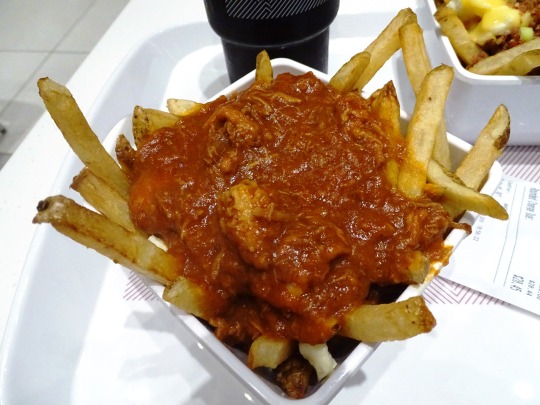
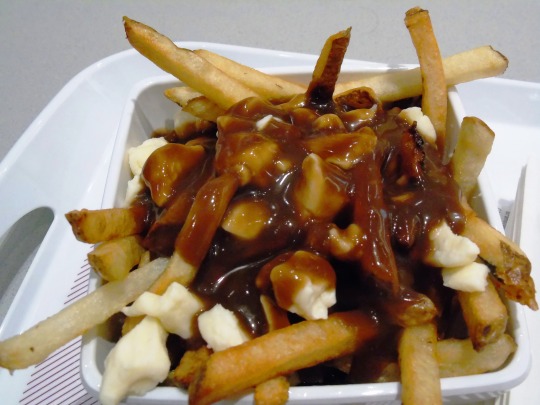
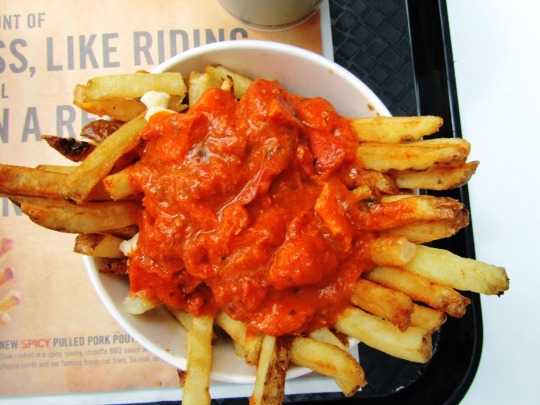
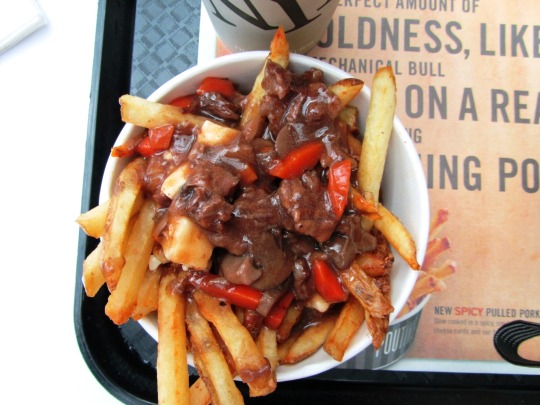
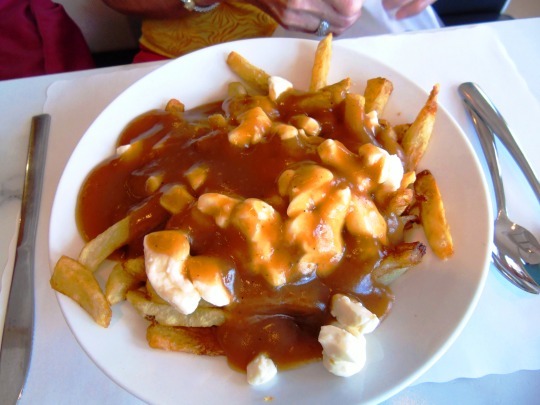
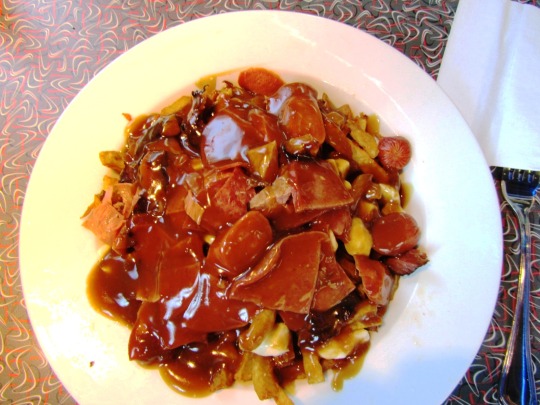
National Cheese Curd Day
National Cheese Curd Day was created by Culver's, a fast-food restaurant that started in Wisconsin that is located mainly in the Midwest, that as of 2020 has restaurants in 25 states. One of their most popular menu items, their cheese curds, are made with white and yellow Cheddar cheese. The fresh cheese curds—which they source from LaGrander's Hillside Dairy in Stanley, Wisconsin—are breaded with their signature blend of herbs and spices and then deep-fried. Culver's sold over 17.7 million orders of cheese curds in 2015, and over 28 million orders in 2018. During the month of October, when they hold National Cheese Curd Day, they offer chances for people to win cheese curds and other prizes. They've even given away a year's supply of cheese curds as their grand prize.
Cheese curds are popular in the Midwest, particularly in Wisconsin. They also are common in Quebec, Canada. Cheese curds are fresh, made by separating the curd from whey during the cheese-making process. Instead of going through the whole process, where a block of cheese is made, a solid curd of cheese with a milky flavor is formed. Cheese curds are mainly made of young Cheddar, either white or yellow, although some are made from mozzarella, Muenster, Colby, or Monterey Jack cheese. Fresh cheese curds are moist and rubberlike and will squeak when eaten when their elastic protein strands rub against tooth enamel. They begin losing their squeakiness after 12 hours and are no longer considered fresh about two days after being made. They are rather mild in flavor with a bit of saltiness and are often flavored with dill, garlic, spicy Cajun, taco seasoning, ranch, or jalapeno.
Cheese curds are commonly eaten as a snack or appetizer. Not only can they be eaten fresh, but they can be deep-fried, after being covered with a breading or batter—sometimes a beer batter. They are often then dipped in marinara sauce, ketchup, or ranch dressing. Deep-fried cheese curds are popular at state fairs, carnivals, and bars. They are also common at some fast-food restaurants, Culvers and A&W being two that offer them. Cheese curds are also used to make poutine. No matter if you eat deep-fried cheese curds at Culver's today, or enjoy them somewhere else or made in another manner, you are sure to find National Cheese Curd Day most enjoyable!
How to Observe National Cheese Curd Day
Some ways to observe National Cheese Curd Day include:
Pick up some cheese curds at Culver's. Watch their social media accounts for chances to win cheese curds and other swag.
Have some cheese curds at another restaurant, at a bar, or at a carnival or fair.
Pick up some fresh cheese curds at a store or shop, or make your own.
Make your own deep-fried cheese curds.
Plan a trip to the next Cheese Curd Festival.
Source
#Pulled Pork Poutine#National Cheese Curd Day#street food#restaurant#travel#Canada#Le Roy Jucep#Poutine 911#Drummondville#Québec#Montréal#vacation#original photography#15 October#NationalCheeseCurdDay#Meat Lovers Poutine#Butter Chicken Poutine#fries#gravy
2 notes
·
View notes
Text











National Poutine Day
Savoring a delightful combination of crispy fries, savory gravy, and gooey cheese curds in this Canadian classic dish.
Coming in a wide range of varieties, poutine is a dish that is distinctly Canadian, specifically from French-speaking Quebec, but has made its way to becoming beloved all around the world!
How to Celebrate National Poutine Day
Show some love for this deliciously messy pile of gravy soaked fries and celebrate National Poutine Day in some of these fun ways:
Enjoy Eating Poutine
Those who live near a place that serves poutine (and who in Canada doesn’t?!) might want to head over to order some up at a local restaurant.
The good news, however, is that just about anyone, even those with very low culinary skills, can probably whip up a batch of poutine at home.
Hop online to search up a recipe that includes pre-made frozen French fries, along with some cheese curds and a simple gravy sauce. Grab a friend to share it with because it’s a delight to enjoy in honor of National Poutine Day!
Learn and Share Fun Facts About Poutine
Increase the hype about this delicious and delightful dish by sharing some interesting bits of trivia with friends, family members or co-workers in honor of National Poutine Day. Or, even better, head over to social media and make a post that shares photos or some of these fun facts to get others involved in the day:
In 2019, the town of Warwick, Quebec in Canada beat the Guinness World Record for the largest poutine, weighing in at more than 3000 kilos (over 6600 pounds)
Though it was invented in the 1950s, the word poutine didn’t make it into Webster’s dictionary until 2014
The name for poutine loosely means ‘mess’ or ‘hot mess’, but also may have originated from a local word for ‘pudding’
History of National Poutine Day
Poutine has a rich history that is a bit hard to pin down – sort of like the ingredients in the dish itself! It was rumored to have been invented in Quebec in the 1950s, when a customer requested squeaky cheese curds on top of his French fries.
Originally served in a paper bag, the food is rumored to have evolved to include ketchup and vinegar, and then later gravy to keep it warm.
Other similar stories have been told, but the origins of this plate of gravy-soaked fries are really less important than the fact that it deserves to be celebrated.
In recent years, poutine has become a foundation for a number of different dishes and varieties, some that are approved of and some that Canadians find appalling. For instance, Italian poutine is topped with spaghetti sauce, Spicy poutine has Tabasco sauce in the gravy, and Galvaude poutine contains shredded chicken and peas.
National Poutine Day has been celebrated for more than a decade, and rumor has it that it was founded in 2014 by film producer and restaurant owner Danny Rodriguez of Smoke’s Poutinerie in California.
While some people seem to celebrate on March 5th, it seems to be more commonly observed on April 11. Of course, no die-hard poutine fans should be stopped from celebrating twice!
National Poutine Day FAQs
How did poutine get its name?
The name “poutine” likely originates from Quebecois slang for “a mess,” reflecting its rustic, comfort-food appeal.
It was first used in rural Quebec diners in the 1950s, describing the unusual combination of fries, cheese curds, and gravy.
This slang also mirrors how the dish mixes different ingredients into a single hearty meal.
Is there a world record related to poutine?
Yes, competitive eater Joey Chestnut holds the record for consuming 28 pounds of poutine in just 10 minutes.
The challenge took place during the World Poutine Eating Championship in Toronto.
His achievement highlights the dish’s enduring appeal and the lengths fans will go to celebrate it.
How do different regions customize poutine?
Poutine has inspired endless regional variations. In Italy, it’s topped with bolognese sauce and parmesan cheese, creating Italian poutine.
In Quebec, Galvaude adds shredded chicken and peas, giving the dish a homey twist.
Other international versions use toppings like kimchi, pulled pork, or even foie gras.
What is La Poutine Week?
La Poutine Week is a global festival where restaurants craft creative poutine dishes for a week of fun competition.
The event began in Montreal but has since spread to cities across Canada and even the U.S. Restaurants compete for titles like “Most Original Poutine,” while diners celebrate their love for the iconic dish.
Did poutine ever appear at a White House event?
Yes, poutine made its way to the White House during a 2016 state dinner hosted by President Obama.
It was included as part of the menu honoring Canadian Prime Minister Justin Trudeau.
The dish’s appearance at this high-profile event showcased its rise from humble beginnings to global fame.
Are there poutine-flavored products?
Surprisingly, poutine has inspired unusual spin-offs like Jones Soda’s limited-edition poutine-flavored drink.
Released in Canada, the soda aimed to capture the dish’s signature flavors in beverage form.
Though polarizing, the product shows how poutine continues to influence creative food trends.
How do other countries celebrate poutine?
New Zealand-based Giapo’s Ice Cream created a poutine-inspired dessert featuring fries topped with caramel and oolong matcha tea.
In France, similar dishes often include duck confit as a topping.
These adaptations reflect how other cultures embrace poutine while adding their own culinary flair.
What are some myths about poutine’s origin?
Several Quebec diners claim to have invented poutine in the late 1950s, leading to debates over its birthplace.
The most common tale credits Fernand Lachance, who reportedly exclaimed “Ça va faire une maudite poutine!” (“That’ll make a damn mess!”) when combining fries, cheese, and gravy.
These competing stories have become part of the dish’s charm and mystery.
How has poutine influenced pop culture?
Poutine has appeared in movies, TV shows, and even inspired themed restaurants worldwide.
In Canada, poutine-eating contests are a regular feature at food festivals. Its inclusion in pop culture cements its role as a symbol of indulgence and Canadian pride.
Is poutine considered Canada’s national dish?
While poutine is widely associated with Canadian cuisine, it’s seen more as a Quebecois specialty than a national dish.
Some Canadians debate whether maple syrup or butter tarts better reflect the country’s culinary identity.
Regardless, poutine’s popularity across provinces makes it a close contender.
Source
#National Poutine Day#Pulled Pork Poutine#Bacon Double Cheese Poutine#Poutine the Works#travel#Canada#Poutine 911#Le Roy Jucep#Drummondville#Québec#street food#restaurant#Meat Lovers Poutine#Butter Chicken Poutine#vacation#National Poutine Day#NationalPoutineDay#tourist attraction#national day#Poutin#original photography#11 April
1 note
·
View note
Text
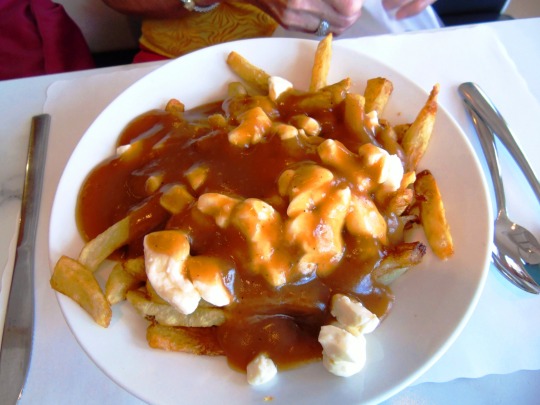
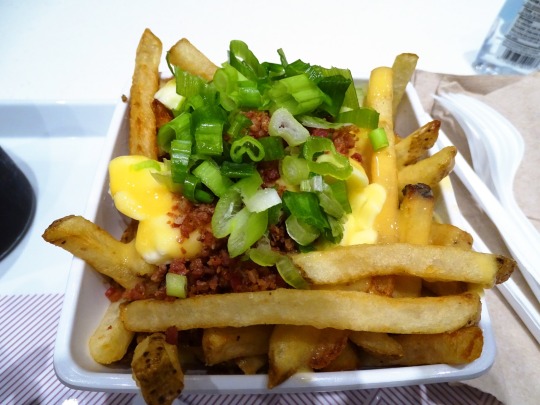
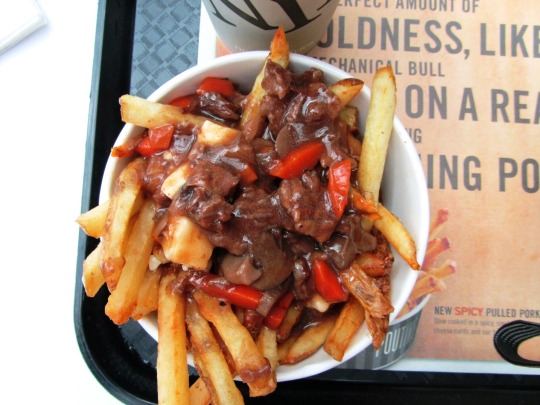








National Poutine Day
While in Winnipeg, Manitoba, filming Bravetown, Danny Rodriguez gained an affinity for poutine. Following his return to the United States he created National Poutine Day, and with partners, opened a Smoke’s Poutinerie branch in Berkeley, California, the first location of the chain in the country. While the Berkeley restaurant has since closed, the poutine holiday he created continues to be celebrated!
In Canada, particularly in Quebec, poutine is a staple food, if not also an iconic one. It has become a popular food in America as well as in other countries. Standard poutine is made up of fresh-cut french fries, squeaky fresh cheese curds, and brown gravy, but there are many variations of the dish. Among other possibilities, the name may have come from the word “pudding,” which is spelled pouding in French, or from poutine, which is slang for “mess” in Quebec. It is pronounced “pou-tin” in the French-dominated regions of Quebec and New Brunswick, but as “poo-teen” elsewhere.
According to the most widely known and accepted story, poutine was first served at L'Idéal (Café Ideal)—a restaurant that later changed its name to Le Lutin Qui Rit (The Laughing Elf)—in 1957, in the small town of Warwick, in Arthabaska County, Quebec, a town known for producing squeaky cheese curds. A usual customer, Eddy Lainsesse, requested curds on top of his fries. The restaurant owner, Fernand Lachance, supposedly replied, “Ça va faire une maudite poutine,” which roughly translates to “That’s going to make a dreadful mess.” A variation of the story says that Lainsesse asked for the curds and fries to be thrown together in a paper bag, upon which Lachance looked into the bag and said, “This is poutine.” The dish started being sold in a bag and soon caught on. Patrons began adding ketchup and vinegar to it. In 1963, Lachance began serving it on plates. Customers soon noticed that the fries got cold quickly, so Lachance added gravy to keep them warm.
According to another story, poutine was created by Jean-Paul Roy, owner of Le Roy Jucep, a drive-in restaurant in Drummondville, Quebec. He had been serving a dish of gravy and french fries called palate-sauce since 1958, and in 1964 noticed that some of his diners were adding cheese curds to it. He soon added a dish that contained all three ingredients and named it fromage-palate-sauce.
No matter how poutine got its start, it soon could be found being sold as street food in Canada. By 1969 it was being sold in Quebec City at the Ashton Snack Bar food truck on Boulevard Wilfred-Hamel, and it was being sold in Montreal by 1983. By the early 1980s, it had become a widely popular street food in Ontario and Quebec.
It made its debut in Canadian chain restaurants in 1985, appearing on the menu at Frits, a now-defunct Quebec-based chain. By the 1990s, poutine had reached mass popularization in the country, after its inclusion on the menus of other chains. It first appeared on a Burger King menu in 1987 in Quebec, and soon spread to other locations of the chain. The same happened with McDonald’s in 1990. Canadian fast-food chain Harvey’s debuted it on menus across the country in 1992.
But poutine wasn’t to remain only as street food and fast food. By the early 2000s, it was appearing in high-end Canadian restaurants. It was put on the menu at Aud Pied de Cochon in Montreal in 2002, where it was topped with foie gras. Other high-end Montreal restaurants followed suit. Garde Manger began serving an Iron Chef America-winning lobster poutine, and Pub Quartier Latin put poutine made with steak, truffles, and red wine demi-glace on their menu.
Some Canadian restaurants have made poutine their main focus. La Banquise in Montreal began serving it in the 1980s. They started with the standard version and an Italian version with bolognese sauce instead of gravy. They have since expanded to serving 30 types. Smoke’s Poutinerie was started in Toronto in 2008, the first poutine-only restaurant in that city. Other poutine-only restaurants that followed in Canada are Poutini’s House of Poutine, La Poutinerie, and Poutineville.
Poutine made its first foray into the United States in New Jersey and New York, where a variation of the recipe called “Disco Fries” became popular. This version substituted mozzarella or cheddar cheese for the curds. Poutine has since become relatively common in the States and has taken hold in other countries as well, such as the United Kingdom and Russia.
As mentioned, there are various types of poutine besides the usual french fries, cheese curds, and gravy combination. Different types of potatoes, cheese, and sauces can be used. Italian poutine may use spaghetti sauce instead of gravy; veggie poutine is made with mushroom sauce and vegetables; Irish poutine is made with lardons. La galvaude is from Gaspésie and is made with chicken and green peas. A variation in Montreal uses smoked meat. With so many types of poutine—and so many restaurants that serve it around the world—there is no reason to remain hungry on National Poutine Day!
How to Observe National Poutine Day
There are numerous ways to celebrate!
Make your own poutine. You could make the original version or another variation of the dish. You could even make Disco Fries, the Americanized version of the dish.
Check if there is a place near you that serves poutine.
Have poutine at one of the best places in the United States that serve it.
Enjoy poutine at a Smoke’s Poutinerie or at another Canadian restaurant that specializes in the dish, such as La Banquise, Poutini’s House of Poutine, La Poutinerie, or Poutineville.
Have poutine at a restaurant in Warwick, Quebec, the town where the dish is said to have originated, or have it at Le Roy Jucep in Drummondville, Quebec, the other location where it is said to have gotten its start.
Eat some poutine at Harvey’s or at another Canadian fast-food restaurant.
Enjoy poutine at a high-end Canadian restaurant such as Au Pied de Cochon, Garde Manger, or Pub Quartier Latin.
Plan a trip to an upcoming poutine fest, such as Montreal’s La Grand Poutinefest or Ottawa Poutine Fest.
Source
#Pulled Pork Poutine#Bacon Double Cheese Poutine#Poutine the Works#travel#Canada#Poutine 911#Le Roy Jucep#Drummondville#Québec#street food#restaurant#Meat Lovers Poutine#Butter Chicken Poutine#vacation#National Poutine Day#5 March#NationalPoutineDay#tourist attraction#national day#Poutin#original photography
1 note
·
View note
Photo

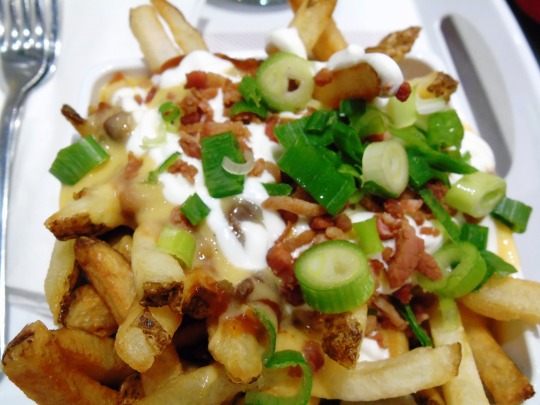
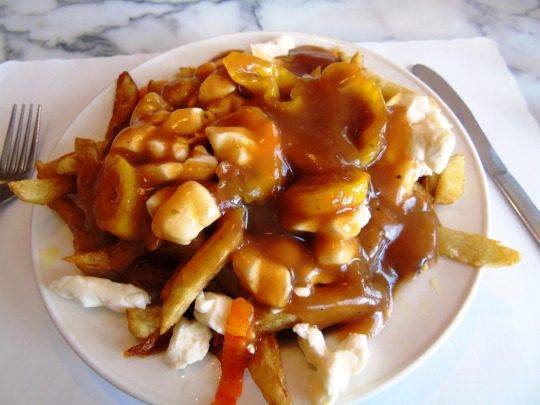
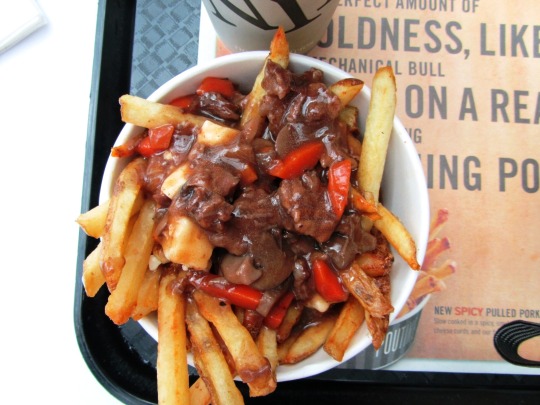
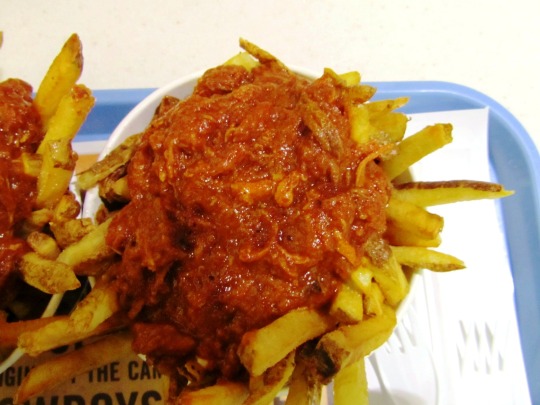
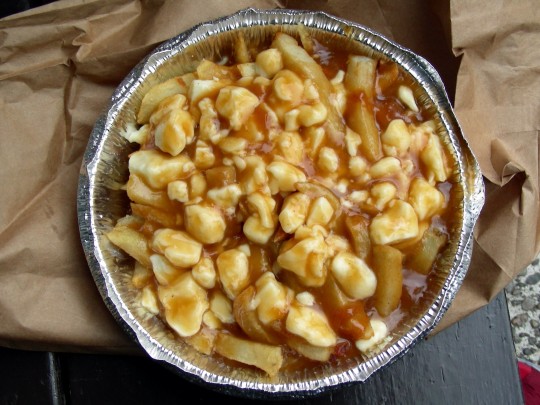




National Poutine Day
In Canada, particularly in Quebec, poutine is a staple food, if not also an iconic one. It has become a popular food in America as well as in other countries, and we celebrate it today, on National Poutine Day. Standard poutine is made up of fresh-cut french fries, squeaky fresh cheese curds, and brown gravy, but there are many variations of the dish. Among other possibilities, the name may have come from the word "pudding," which is spelled pouding in French, or from poutine, which is slang for "mess" in Quebec. It is pronounced "pou-tin" in the French-dominated regions of Quebec and New Brunswick, but as "poo-teen" elsewhere.
According to the most widely known and accepted story, poutine was first served at L’Idéal (Café Ideal)—a restaurant that later changed its name to Le Lutin Qui Rit (The Laughing Elf)—in 1957, in the small town of Warwick, in Arthabaska County, Quebec, a town known for producing squeaky cheese curds. A usual customer, Eddy Lainsesse, requested curds on top of his fries. The restaurant owner, Fernand Lachance, supposedly replied, "Ça va faire une maudite poutine," which roughly translates to "That's going to make a dreadful mess." A variation of the story says that Lainsesse asked for the curds and fries to be thrown together in a paper bag, upon which Lachance looked into the bag and said, "This is poutine." The dish started being sold in a bag and soon caught on. Patrons began adding ketchup and vinegar to it. In 1963, Lachance began serving it on plates. Customers soon noticed that the fries got cold quickly, so Lachance added gravy to keep them warm.
According to another story, poutine was created by Jean-Paul Roy, owner of Le Roy Jucep, a drive-in restaurant in Drummondville, Quebec. He had been serving a dish of gravy and french fries called patate-sauce since 1958, and in 1964 noticed that some of his diners were adding cheese curds to it. He soon added a dish that contained all three ingredients and named it fromage-patate-sauce.
No matter how poutine got its start, it soon could be found being sold as street food in Canada. By 1969 it was being sold in Quebec City at the Ashton Snack Bar food truck on Boulevard Wilfred-Hamel, and it was being sold in Montreal by 1983. By the early 1980s, it had become a widely popular street food in Ontario and Quebec.
It made its debut in Canadian chain restaurants in 1985, appearing on the menu at Frits, a now-defunct Quebec-based chain. By the 1990s, poutine had reached mass popularization in the country, after its inclusion on the menus of other chains. It first appeared on a Burger King menu in 1987 in Quebec, and soon spread to other locations of the chain. The same happened with McDonald's in 1990. Canadian fast-food chain Harvey's debuted it on menus across the country in 1992.
But poutine wasn't to remain only as street food and fast food. By the early 2000s, it was appearing in high-end Canadian restaurants. It was put on the menu at Aud Pied de Cochon in Montreal in 2002, where it was topped with foie gras. Other high-end Montreal restaurants followed suit. Garde Manger began serving an Iron Chef America-winning lobster poutine, and Pub Quartier Latin put poutine made with steak, truffles, and red wine demi-glace on their menu.
Some Canadian restaurants have made poutine their main focus. La Banquise in Montreal began serving it in the 1980s. They started with the standard version and an Italian version with bolognese sauce instead of gravy. They have since expanded to serving 30 types. Smoke's Poutinerie was started in Toronto in 2008, the first poutine-only restaurant in that city. Other poutine-only restaurants that followed in Canada are Poutini's House of Poutine, La Poutinerie, and Poutineville.
Poutine made its first foray into the United States in New Jersey and New York, where a variation of the recipe called "Disco Fries" became popular. This version substituted mozzarella or cheddar cheese for the curds. Poutine has since become relatively common in the States, and took hold in other countries as well, such as the United Kingdom and Russia.
As mentioned, there are various types of poutine besides the usual french fries, cheese curds, and gravy combination. Different types of potatoes, cheese, and sauces can be used. Italian poutine may use spaghetti sauce instead of gravy; veggie poutine is made with mushroom sauce and vegetables; Irish poutine is made with lardons. La galvaude is from Gaspésie and is made with chicken and green peas. A variation in Montreal uses smoked meat.
Festivals devoted to poutine are held across Canada throughout the year. Montreal, Ottawa, and Toronto are some cities that hold them. On National Poutine Day, events are held and specials are available at restaurants in countries like Canada and the United States. For example, My Meatball Place in Toronto has given away free samples of meatball and vegan poutine, and The Hops Spot in Syracuse has offered half-price poutine. With so many types of poutine—and so many restaurants that serve it in some parts of the world—there is no reason to remain hungry on National Poutine Day.
How to Observe National Poutine Day (Canada)
Here are some ideas on how to celebrate the day:
Make your own poutine. You could make the original version or another variation of the dish. You could even make Disco Fries, the Americanized version of the dish.
Check if there is a place near you that serves poutine.
Enjoy poutine at a Canadian restaurant that specializes in the dish, such as La Banquise, Smoke's Poutinerie, Poutini's House of Poutine, La Poutinerie, or Poutineville. Smoke's Poutinerie also has some locations in the United States.
Have poutine at a restaurant in Warwick, Quebec, the town where the dish is said to have originated, or have it at Le Roy Jucep in Drummondville, Quebec, the other location where it is said to have gotten its start.
Eat some poutine at Harvey's or at another fast food restaurant in Canada.
Enjoy poutine at a high-end Canadian restaurant such as Aud Pied de Cochon, Garde Manger, or Pub Quartier Latin.
See if there are any specials on poutine today at restaurants such as My Meatball Place in Toronto or The Hops Spot in Syracuse.
Plan a trip to an upcoming poutine fest, such as Montreal's Le Grand Poutinefest, Ottawa Poutine Fest, or Toronto Poutine Fest.
Source
#Poutine 911#Le Roy Jucep#the original one#Drummondville#Québec#travel#summer 2015#food#fries#cheese curd#gravy#restaurant#Poutine the Works#Bacon Double Cheese Poutine#Pulled Pork Poutine#Butter Chicken Poutine#Meat Lovers Poutine#National Poutine Day#Canada#NationalPoutineDayCanada#11 April#street food#vacation#2018#2012#Montréal
94 notes
·
View notes
Photo










National Poutine Day
While in Winnipeg, Manitoba, filming Bravetown, Danny Rodriguez gained an affinity for poutine. Following his return to the United States he created National Poutine Day, and with partners, opened a Smoke's Poutinerie branch in Berkeley, California, the first location of the chain in the country. While the Berkeley restaurant has since closed, the poutine holiday he created continues to be celebrated!
In Canada, particularly in Quebec, poutine is a staple food, if not also an iconic one. It has become a popular food in America as well as in other countries. Standard poutine is made up of fresh-cut french fries, squeaky fresh cheese curds, and brown gravy, but there are many variations of the dish. Among other possibilities, the name may have come from the word "pudding," which is spelled pouding in French, or from poutine, which is slang for "mess" in Quebec. It is pronounced "pou-tin" in the French-dominated regions of Quebec and New Brunswick, but as "poo-teen" elsewhere.
According to the most widely known and accepted story, poutine was first served at L'Idéal (Café Ideal)—a restaurant that later changed its name to Le Lutin Qui Rit (The Laughing Elf)—in 1957, in the small town of Warwick, in Arthabaska County, Quebec, a town known for producing squeaky cheese curds. A usual customer, Eddy Lainsesse, requested curds on top of his fries. The restaurant owner, Fernand Lachance, supposedly replied, "Ça va faire une maudite poutine," which roughly translates to "That's going to make a dreadful mess." A variation of the story says that Lainsesse asked for the curds and fries to be thrown together in a paper bag, upon which Lachance looked into the bag and said, "This is poutine." The dish started being sold in a bag and soon caught on. Patrons began adding ketchup and vinegar to it. In 1963, Lachance began serving it on plates. Customers soon noticed that the fries got cold quickly, so Lachance added gravy to keep them warm.
According to another story, poutine was created by Jean-Paul Roy, owner of Le Roy Jucep, a drive-in restaurant in Drummondville, Quebec. He had been serving a dish of gravy and french fries called palate-sauce since 1958, and in 1964 noticed that some of his diners were adding cheese curds to it. He soon added a dish that contained all three ingredients and named it fromage-palate-sauce.
No matter how poutine got its start, it soon could be found being sold as street food in Canada. By 1969 it was being sold in Quebec City at the Ashton Snack Bar food truck on Boulevard Wilfred-Hamel, and it was being sold in Montreal by 1983. By the early 1980s, it had become a widely popular street food in Ontario and Quebec.
It made its debut in Canadian chain restaurants in 1985, appearing on the menu at Frits, a now-defunct Quebec-based chain. By the 1990s, poutine had reached mass popularization in the country, after its inclusion on the menus of other chains. It first appeared on a Burger King menu in 1987 in Quebec, and soon spread to other locations of the chain. The same happened with McDonald's in 1990. Canadian fast-food chain Harvey's debuted it on menus across the country in 1992.
But poutine wasn't to remain only as street food and fast food. By the early 2000s, it was appearing in high-end Canadian restaurants. It was put on the menu at Aud Pied de Cochon in Montreal in 2002, where it was topped with foie gras. Other high-end Montreal restaurants followed suit. Garde Manger began serving an Iron Chef America-winning lobster poutine, and Pub Quartier Latin put poutine made with steak, truffles, and red wine demi-glace on their menu.
Some Canadian restaurants have made poutine their main focus. La Banquise in Montreal began serving it in the 1980s. They started with the standard version and an Italian version with bolognese sauce instead of gravy. They have since expanded to serving 30 types. Smoke's Poutinerie was started in Toronto in 2008, the first poutine-only restaurant in that city. Other poutine-only restaurants that followed in Canada are Poutini's House of Poutine, La Poutinerie, and Poutineville.
Poutine made its first foray into the United States in New Jersey and New York, where a variation of the recipe called "Disco Fries" became popular. This version substituted mozzarella or cheddar cheese for the curds. Poutine has since become relatively common in the States and has taken hold in other countries as well, such as the United Kingdom and Russia.
As mentioned, there are various types of poutine besides the usual french fries, cheese curds, and gravy combination. Different types of potatoes, cheese, and sauces can be used. Italian poutine may use spaghetti sauce instead of gravy; veggie poutine is made with mushroom sauce and vegetables; Irish poutine is made with lardons. La galvaude is from Gaspésie and is made with chicken and green peas. A variation in Montreal uses smoked meat. With so many types of poutine—and so many restaurants that serve it around the world—there is no reason to remain hungry on National Poutine Day!
How to Observe National Poutine Day
There are numerous ways to celebrate!
Make your own poutine. You could make the original version or another variation of the dish. You could even make Disco Fries, the Americanized version of the dish.
Check if there is a place near you that serves poutine.
Have poutine at one of the best places in the United States that serve it.
Enjoy poutine at a Smoke's Poutinerie or at another Canadian restaurant that specializes in the dish, such as La Banquise, Poutini's House of Poutine, La Poutinerie, or Poutineville.
Have poutine at a restaurant in Warwick, Quebec, the town where the dish is said to have originated, or have it at Le Roy Jucep in Drummondville, Quebec, the other location where it is said to have gotten its start.
Eat some poutine at Harvey's or at another Canadian fast-food restaurant.
Enjoy poutine at a high-end Canadian restaurant such as Au Pied de Cochon, Garde Manger, or Pub Quartier Latin.
Plan a trip to an upcoming poutine fest, such as Montreal's La Grand Poutinefest or Ottawa Poutine Fest.
Source
#Bacon Double Cheese Poutine#Pulled Pork Poutine#National Poutine Day#NationalPoutineDay#5 March#street food#restaurant#travel#vacation#tourism#fries#cheese curd#gravy#original photography#Ottawa#Vancouver#Calgary#Le Roy Jucep#Drummondville#Québec#Poutine 911#Butter Chicken Poutine#Pulled Beef Poutine#Meat Lovers Poutine#Montréal#Poutine The Works#Canada
4 notes
·
View notes
Photo









National Cheese Curd Day
National Cheese Curd Day was created by Culver’s, a fast-food restaurant that started in Wisconsin that is located mainly in the Midwest, that as of 2020 has restaurants in 25 states. One of their most popular menu items, their cheese curds, are made with white and yellow Cheddar cheese. The fresh cheese curds—which they source from LaGrander’s Hillside Dairy in Stanley, Wisconsin—are breaded with their signature blend of herbs and spices and then deep-fried. Culver’s sold over 17.7 million orders of cheese curds in 2015, and over 28 million orders in 2018. During the month of October, when they hold National Cheese Curd Day, they offer chances for people to win cheese curds and other prizes. They’ve even given away a year’s supply of cheese curds as their grand prize.
Cheese curds are popular in the Midwest, particularly in Wisconsin. They also are common in Quebec, Canada. Cheese curds are fresh, made by separating the curd from whey during the cheese-making process. Instead of going through the whole process, where a block of cheese is made, a solid curd of cheese with a milky flavor is formed. Cheese curds are mainly made of young Cheddar, either white or yellow, although some are made from mozzarella, Muenster, Colby, or Monterey Jack cheese. Fresh cheese curds are moist and rubberlike and will squeak when eaten when their elastic protein strands rub against tooth enamel. They begin losing their squeakiness after 12 hours and are no longer considered fresh about two days after being made. They are rather mild in flavor with a bit of saltiness and are often flavored with dill, garlic, spicy Cajun, taco seasoning, ranch, or jalapeno.
Cheese curds are commonly eaten as a snack or appetizer. Not only can they be eaten fresh, but they can be deep-fried, after being covered with a breading or batter—sometimes a beer batter. They are often then dipped in marinara sauce, ketchup, or ranch dressing. Deep-fried cheese curds are popular at state fairs, carnivals, and bars. They are also common at some fast-food restaurants, Culvers and A&W being two that offer them. Cheese curds are also used to make poutine. No matter if you eat deep-fried cheese curds at Culver’s today, or enjoy them somewhere else or made in another manner, you are sure to find National Cheese Curd Day most enjoyable!
Source
#Le Roy Jucep#National Cheese Curd Day#NationalCheeseCurdDay#Canada#Poutine#Bacon Double Cheese Poutine#Pulled Pork Poutine#street food#restaurant#original photography#travel#vacation#Québec#Montréal#Poutine 911#Butter Chicken Poutine#Meat Lovers Poutine#Pulled Beef Poutine#15 October
2 notes
·
View notes
Photo










National Poutine Day
In Canada, particularly in Quebec, poutine is a staple food, if not also an iconic one. It has become a popular food in America as well as in other countries, and we celebrate it today, on National Poutine Day. Standard poutine is made up of fresh-cut french fries, squeaky fresh cheese curds, and brown gravy, but there are many variations of the dish. Among other possibilities, the name may have come from the word "pudding," which is spelled pouding in French, or from poutine, which is slang for "mess" in Quebec. It is pronounced "pou-tin" in the French-dominated regions of Quebec and New Brunswick, but as "poo-teen" elsewhere.
According to the most widely known and accepted story, poutine was first served at L'Idéal (Café Ideal)—a restaurant that later changed its name to Le Lutin Qui Rit (The Laughing Elf)—in 1957, in the small town of Warwick, in Arthabaska County, Quebec, a town known for producing squeaky cheese curds. A usual customer, Eddy Lainsesse, requested curds on top of his fries. The restaurant owner, Fernand Lachance, supposedly replied, "Ça va faire une maudite poutine," which roughly translates to "That's going to make a dreadful mess." A variation of the story says that Lainsesse asked for the curds and fries to be thrown together in a paper bag, upon which Lachance looked into the bag and said, "This is poutine." The dish started being sold in a bag and soon caught on. Patrons began adding ketchup and vinegar to it. In 1963, Lachance began serving it on plates. Customers soon noticed that the fries got cold quickly, so Lachance added gravy to keep them warm.
According to another story, poutine was created by Jean-Paul Roy, owner of Le Roy Jucep, a drive-in restaurant in Drummondville, Quebec. He had been serving a dish of gravy and french fries called patate-sauce since 1958, and in 1964 noticed that some of his diners were adding cheese curds to it. He soon added a dish that contained all three ingredients and named it fromage-patate-sauce.
No matter how poutine got its start, it soon could be found being sold as street food in Canada. By 1969 it was being sold in Quebec City at the Ashton Snack Bar food truck on Boulevard Wilfred-Hamel, and it was being sold in Montreal by 1983. By the early 1980s, it had become a widely popular street food in Ontario and Quebec.
It made its debut in Canadian chain restaurants in 1985, appearing on the menu at Frits, a now-defunct Quebec-based chain. By the 1990s, poutine had reached mass popularization in the country, after its inclusion on the menus of other chains. It first appeared on a Burger King menu in 1987 in Quebec, and soon spread to other locations of the chain. The same happened with McDonald's in 1990. Canadian fast-food chain Harvey's debuted it on menus across the country in 1992.
But poutine wasn't to remain only as street food and fast food. By the early 2000s, it was appearing in high-end Canadian restaurants. It was put on the menu at Aud Pied de Cochon in Montreal in 2002, where it was topped with foie gras. Other high-end Montreal restaurants followed suit. Garde Manger began serving an Iron Chef America-winning lobster poutine, and Pub Quartier Latin put poutine made with steak, truffles, and red wine demi-glace on their menu.
Some Canadian restaurants have made poutine their main focus. La Banquise in Montreal began serving it in the 1980s. They started with the standard version and an Italian version with bolognese sauce instead of gravy. They have since expanded to serving 30 types. Smoke's Poutinerie was started in Toronto in 2008, the first poutine-only restaurant in that city. Other poutine-only restaurants that followed in Canada are Poutini's House of Poutine, La Poutinerie, and Poutineville.
Poutine made its first foray into the United States in New Jersey and New York, where a variation of the recipe called "Disco Fries" became popular. This version substituted mozzarella or cheddar cheese for the curds. Poutine has since become relatively common in the States, and took hold in other countries as well, such as the United Kingdom and Russia.
As mentioned, there are various types of poutine besides the usual french fries, cheese curds, and gravy combination. Different types of potatoes, cheese, and sauces can be used. Italian poutine may use spaghetti sauce instead of gravy; veggie poutine is made with mushroom sauce and vegetables; Irish poutine is made with lardons. La galvaude is from Gaspésie and is made with chicken and green peas. A variation in Montreal uses smoked meat.
Festivals devoted to poutine are held across Canada throughout the year. Montreal, Ottawa, and Toronto are some cities that hold them. On National Poutine Day, events are held and specials are available at restaurants in countries like Canada and the United States. For example, My Meatball Place in Toronto has given away free samples of meatball and vegan poutine, and The Hops Spot in Syracuse has offered half-price poutine. With so many types of poutine—and so many restaurants that serve it in some parts of the world—there is no reason to remain hungry on National Poutine Day.)
Make your own poutine. You could make the original version or another variation of the dish. You could even make Disco Fries, the Americanized version of the dish.
Check if there is a place near you that serves poutine.
Enjoy poutine at a Canadian restaurant that specializes in the dish, such as La Banquise, Smoke's Poutinerie, Poutini's House of Poutine, La Poutinerie, or Poutineville. Smoke's Poutinerie also has some locations in the United States.
Have poutine at a restaurant in Warwick, Quebec, the town where the dish is said to have originated, or have it at Le Roy Jucep in Drummondville, Quebec, the other location where it is said to have gotten its start.
Eat some poutine at Harvey's or at another fast food restaurant in Canada.
Enjoy poutine at a high-end Canadian restaurant such as Aud Pied de Cochon, Garde Manger, or Pub Quartier Latin.
See if there are any specials on poutine today at restaurants such as My Meatball Place in Toronto or The Hops Spot in Syracuse.
Plan a trip to an upcoming poutine fest, such as Montreal's Le Grand Poutinefest, Ottawa Poutine Fest, or Toronto Poutine Fest.
Source
#Pulled Pork Poutine#National Poutine Day#NationalPoutineDayCanada#travel#11 April#Bacon Double Cheese Poutine#New York Fries#street food#Canada#restaurant#Poutine The Works#Le Roy Jucep#Poutine 911#Québec#Ottawa#Calgary#Ontario#Alberta#Spicy Pulled Poutine#Butter Chicken Poutine#original photography#Meat Lovers Poutince#BC#Vancouver#Pulled Beef Poutine#British Columbia#Montréal#cheese#gravy#French Fries
7 notes
·
View notes
Photo









National Cheese Curd Day
National Cheese Curd Day was created by Culver's, a fast-food restaurant that started in Wisconsin that is located mainly in the Midwest, that as of 2020 has restaurants in 25 states. One of their most popular menu items, their cheese curds, are made with white and yellow Cheddar cheese. The fresh cheese curds—which they source from LaGrander's Hillside Dairy in Stanley, Wisconsin—are breaded with their signature blend of herbs and spices and then deep-fried. Culver's sold over 17.7 million orders of cheese curds in 2015, and over 28 million orders in 2018. During the month of October, when they hold National Cheese Curd Day, they offer chances for people to win cheese curds and other prizes. They've even given away a year's supply of cheese curds as their grand prize.
Cheese curds are popular in the Midwest, particularly in Wisconsin. They also are common in Quebec, Canada. Cheese curds are fresh, made by separating the curd from whey during the cheese-making process. Instead of going through the whole process, where a block of cheese is made, a solid curd of cheese with a milky flavor is formed. Cheese curds are mainly made of young Cheddar, either white or yellow, although some are made from mozzarella, Muenster, Colby, or Monterey Jack cheese. Fresh cheese curds are moist and rubberlike and will squeak when eaten when their elastic protein strands rub against tooth enamel. They begin losing their squeakiness after 12 hours and are no longer considered fresh about two days after being made. They are rather mild in flavor with a bit of saltiness and are often flavored with dill, garlic, spicy Cajun, taco seasoning, ranch, or jalapeno.
Cheese curds are commonly eaten as a snack or appetizer. Not only can they be eaten fresh, but they can be deep-fried, after being covered with a breading or batter—sometimes a beer batter. They are often then dipped in marinara sauce, ketchup, or ranch dressing. Deep-fried cheese curds are popular at state fairs, carnivals, and bars. They are also common at some fast-food restaurants, Culvers and A&W being two that offer them. Cheese curds are also used to make poutine. No matter if you eat deep-fried cheese curds at Culver's today, or enjoy them somewhere else or made in another manner, you are sure to find National Cheese Curd Day most enjoyable!
Source
#National Cheese Curd Day#NationalCheeseCurdDay#15 October#Canada#street food#original photography#2018#summer 2015#2012#2009#travel#french fries#Bacon Double Cheese Poutine#Le Roy Jucep#Poutine 911#Canadian food#restaurant#Drummondville#Ottawa#gravy#Calgary#Butter Chicken Poutine#Pulled Beef Poutine#Meat Lovers Poutine#Vancouver#Pulled Pork Poutine#vacation
1 note
·
View note
Photo









National Cheese Curd Day
National Cheese Curd Day is observed annually on October 15. This is a day to enjoy the velvety goodness of cheese curds.
Cheese Curds are unique, funky, snackable little pieces of yellow or white Wisconsin cheddar cheese coated and deep-fried golden brown for a warm buttery crunch on the outside and an ooey-gooey burst of dairyland delicacy on the inside.
About Culvers:
Culver’s was founded in the Dairy State and proudly serves real Wisconsin Cheese Curds. Culver’s and National Day Calendar have officially declared Oct. 15 National Cheese Curd Day so this most delicious of Wisconsin treats gets the attention and adoration it deserves.
Source
#Butter Chicken Poutine#National Cheese Curd Day#NationalCheeseCurdDay#New York Fries#Ottawa#Ontario#Montréal#Québec#food#fast food#restaurant#travel#vacation#2012#2015#2009#Pulled Beef Poutine#Meat Lovers Poutine#Vancouver#Le Roy Jucep#Poutine 911#Bacon Double Cheese Poutine#2018
4 notes
·
View notes